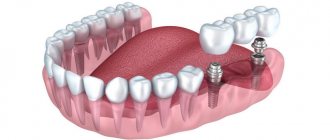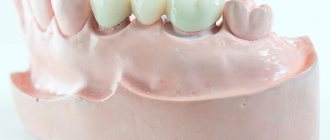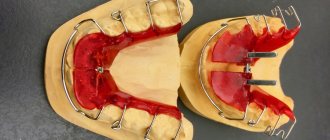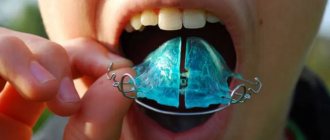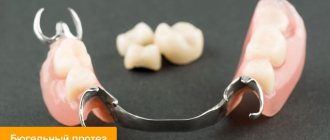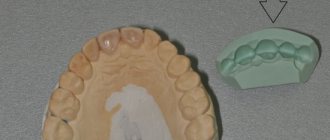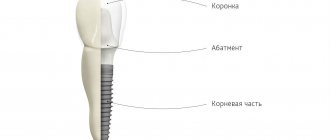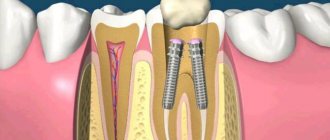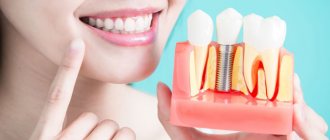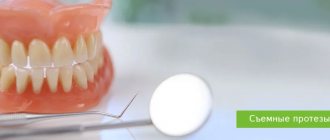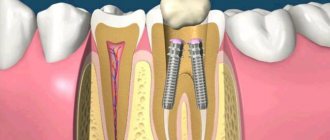Sooner or later, adults ask questions about what types of dental bridges there are, what is best to put on dental units to replace lost incisors, canines and molars. Prosthetics have been used in Dentika dentistry for many years and show good effectiveness at minimal cost. Bridge structures are durable, wear-resistant and aesthetically attractive. They are invisible to the naked eye and do not interfere during a conversation.
Despite the obvious advantages, the technique also has contraindications. The physician should advise the patient and provide information about various materials, design features and possible adverse reactions.
Causes of structure failure
Can a dental bridge fall out immediately after installation? The reasons that a permanent dental bridge falls off after a few days, weeks (less often, months) most often lie in errors in its manufacture or fixation. But the patient’s own fault may also be present here. Let's take a closer look at the factors that cause loss in the early period:
- the use of low-quality cement or its incorrect application,
- the presence of a gap between the inside of the prosthesis and the supporting teeth on which it is placed,
- caries under crowns: this may be undetected caries - it was not noticed during preparation for prosthetics. Or when the supporting tooth was overheated during turning. If, during the passage of root canals, they are poorly processed or sealed, then over time this leads to the spread of infection,
- allergy to prosthetic materials,
- if the patient chewed something very hard with his teeth (including artificial ones), chewed toffee, toffee.
Another reason for loss is poor oral hygiene, when a large amount of plaque and stone accumulates around the crowns. This in itself can lead to the destruction of the ceramic or composite coating of the bridge and partial crumbling of the cement composition. If we consider that dental deposits are inhabited by bacteria that have a negative effect on the gums and roots of the teeth under the prosthesis, then loss can occur due to progressive caries on the supports.
A dental bridge fell out – reasons?
There are several reasons:
- The patient's diet contains sticky foods;
- Sediment has accumulated along the edges of the crown;
- The cement has lost its properties due to the expiration date;
- Habit of chewing hard objects;
- Caries develops under the crown, since pulpless teeth have reduced resistance to negative factors;
- Low teeth do not allow for high-quality fixation;
- Worn cement that does not allow for reliable fixation, then to correct the situation, gently re-fixate using a reliable composite.
- Biomechanical factor – incorrect distribution of chewing load.
Relationship between loss and service life
Dental bridges can fall out due to natural wear and tear or the end of their life. On average it is 5 years. And with good oral hygiene and careful treatment, the bridge will last up to 10 years. If the bridge is supported by implants, the service life increases. For ceramic and metal-ceramic it is at least 10 years, and for zirconium dioxide and ceramic-composite – from 20 years.
“My mother built golden bridges for herself back in the 90s. So, they stayed with her for almost 20 years. Either the doctor was such a good one, or she was taking care of her teeth. But she definitely never ate nuts. And I installed metal-ceramic ones in 2014. And they fell out after only 6 years. The doctor was able to glue them in place, but I understand that it is no longer so convenient. We'll probably have to change it."
Anastasia G., review from gidpozubam.ru
Reasons for loosening of the crown on the pin and inlay
The reason that the crown on the pin began to wobble depends on cementation and correct installation:
- When bonding with dental cement, the quality of the material is of great importance. Its task is to seal the gap between the tooth, the pin and the crown.
- Incorrect installation of the pin (fiberglass pin) in the channel. To use a post, it is important that most of the tooth is preserved. The pin is responsible for stability, but the crown is held on the tooth. If the pin is poorly secured or the tooth is severely damaged, the denture will wobble.
The inlay, unlike the pin, consists of two parts, the pin itself and an element that replicates the tooth. The crown on the inlay is loose if:
- de-cementing occurred;
- parts of the tab have become disconnected.
Re-prosthetics in cases where pins and inlays are used will take longer. It is necessary to install microprostheses in compliance with the technique, correct the defects that led to the loss, and then install a new crown. Attempts to fit a microprosthesis to an old restoration will lead to the fact that the entire structure will have to be changed again.
Rules of conduct when a bridge falls out
What to do if a dental bridge falls off? Often people get lost and don’t know how to behave. Someone almost begins to panic, someone hastily throws the fallen orthopedic structure into the trash. The list below includes simple and understandable rules that will tell you what to do when a dental bridge falls out:
- carefully spit everything out of your mouth onto a napkin if it falls out while eating,
- rinse your mouth with water and then with some solution (chlorhexidine or mouthwash),
- rinse the bridge in clean water, you can clean it with a soft bristle brush: when rinsing and cleaning, make sure that it does not fall into the sink or onto the floor,
- place the prosthesis in a clean handkerchief or piece of sterile bandage,
- put the bridge in a small, clean container so as not to accidentally break the product (in case it can be glued back, although this is unlikely). You will need to take the prosthesis to the clinic in the same container,
- try not to chew on the “affected” side, and also rinse your mouth after each meal (if there is still a lot of time before your visit to the clinic).
When the bridge falls out from clenching the jaws, from pressing with the tongue - that is, when there was no food in the mouth, then immediately go to point number “2” of this list.
If it suddenly turns out that the bridge was swallowed along with food or liquid, then you need to immediately contact a clinic - for example, a therapist, pediatrician, or a hospital emergency room. The sharp edges of the structure can injure the gastrointestinal tract; the bridge can get stuck in the esophagus or intestines. Therefore, you will need to undergo an x-ray or ultrasound. It is important not to make active movements, not to bend over and to adhere to the diet prescribed by the doctor - so that the structure leaves the body naturally. Otherwise, you will have to undergo emergency surgery.
How to remove
Cases when dismantling is required:
- The support was not sufficiently prepared. The doctor performed the filling poorly, resulting in a risk of an inflammatory process.
- The cement composition has collapsed. The restoration procedure is impossible without removing the structure.
- The service life has expired. Old elements are dismantled, and new ones are fixed in their place.
- The crown was produced with a defect. It may not fit tightly and, as a result, injure the mucous membranes in the oral cavity and affect the bite.
- Some parts began to loosen and fall out.
Procedure for the dentist:
- Sawing. The crown is removed using a special tool that prys up the edges. If this is not possible, you need to cut the material. It will not be possible to maintain the integrity of the installation.
- Removal using the Koch apparatus. Under the influence of ultrasonic waves, the cement is destroyed, then the device itself is applied directly. The artificial element is loosened by shocks, but the natural incisors, canines and molars, along with the cavities, remain intact.
Is it painful to remove a dental bridge?
The procedure usually does not cause pain. Painful sensations occur when there is a living unit under the crown in which the inflammatory process has begun. But this rarely happens, because usually bridge structures are installed after pulp removal, that is, pain should be completely absent. If necessary, the doctor will apply anesthesia.
If the product is removed and discomfort persists, this may indicate injury to the mucous membranes or the development of pulpitis or periodontitis. In such a situation, endodontic therapy is indicated.
Is it possible to glue the bridge in place yourself?
What to do and how to secure a dental bridge if it falls out at home? Let us immediately point out that putting a fallen bridge back on your own is not the best idea. Since this can injure the supporting and neighboring teeth, harm the gums (if you suddenly decide to glue the bridge with pharmaceutical cement or household glue). The consequences can be unpredictable - up to the removal of “damaged” teeth or implants. Therefore, it is better to entrust your teeth to a professional dentist.
Bridge design
The main parts of a bridge are artificial teeth (sometimes simulating part of the gum) and fastening in the form of dental crowns, inlays or clasps. In appearance, all this resembles a bridge, hence the name of the prosthesis. Bridges are used to replace from 1 to 4 missing teeth in a row, depending on their type. In this case, to the right and left of the dentition defect there must be healthy teeth that can become a support for the prosthesis and withstand additional chewing pressure, which can reach several tens of kilograms.
The intermediate part of the bridge may have different principles of connection with the mucosa:
- Flushing
. When there is space between the mucous membrane and the dental bridge. A flushable bridge allows food to pass freely under the body of the structure, facilitating hygienic care.
- Tangent
. When the body of the prosthesis touches the mucous membrane on one side, which is important for the anterior area of the teeth, where it is important from a functional, speech and aesthetic point of view. A bridge of this type is usually installed on the front teeth.
- Saddle
. When the dental bridge is completely connected to the mucous membrane, joint to joint. This is not the best option in terms of functionality and reliability, but there are cases when you cannot do without it, for example, in the area of the front teeth.
What will the doctor do?
Which doctor is best to see if a dental bridge has fallen off? In general, dental prosthetics is the domain of an orthopedic dentist. If the prosthesis is on implants, then you will need to visit both an orthopedist and an implantologist, because The problem may be with the implant. Will the doctor be able to fix the old prosthesis? Here you will first need to undergo diagnostics, incl. tomography of the jaw, which will help determine the condition of the bone around the roots, the quality of root canal filling, and identify cracks in the roots.
Read on the topic: features of dental bridges - who is suitable for them, how they are made and installed.
If the support is in order and suitable for prosthetics, and the prosthesis itself has no flaws (i.e., the problem of falling out was only due to low-quality cement), then you can try to glue the old bridge in place. Of course, using new and high-quality cement.
If the doctor considers that the support needs treatment or removal, and also if the prosthesis is made incorrectly or is broken, then in addition to the main treatment, it will be necessary to make a new orthopedic bridge structure or, in principle, a different type of prosthesis.
Methods for removing structures
How to remove once installed artificial products? Is it possible to carry out the procedure quickly and without sawing them? In general, it is possible, but it all depends on the indications, materials and strength of fixation of the product. Today there are several methods for this. It is important to proceed from the individual clinical picture of the patient, what goals are being pursued and what therapeutic indications are available. The methods differ in the time it takes to dismantle the prostheses and the cost of the procedure.
Using a Kopp apparatus
Colloquially, this special drill is referred to as a “crown remover.” Removing artificial installations from the front, lateral and chewing teeth using permanent or temporary cement, as well as from implants with its help is considered the most popular method today. When the device is turned on, it produces shocks that gradually break up the layers of cement located under the product. Next comes the tool, which is a hook. With its help, the orthopedist picks up the edge of the crown and removes it from the cement.
The method is considered low-traumatic and does not cause pain to the patient. The only downside of the method is that sometimes the Kopp apparatus scratches the surface of the crown, so it is unlikely that you will be able to use the prosthesis later - you will need to restore it.
Using the Coronaflex device
This device operates using compressed air. The shock wave supplied by the device specifically destroys the cement. The device operates much more carefully. The lining of the non-removable orthopedic structure does not suffer and is dismantled by the doctor without the slightest scratches or chips.
The instrument is expensive, so removing a permanent prosthesis using the Coronaflex device is not cheap. But it still saves the patient’s money – especially if the non-removable device is made of zirconium dioxide. If successful, the crown can even be reused.
Using ultrasound
With this method, crowns are removed from teeth by loosening the stability of the cement base. This is achieved by using the power of ultrasonic waves2. The removed prosthesis remains completely intact and unharmed.
However, remember: this method is not suitable for every material. If the orthopedic device is fixed to glass ionomer cement (a mixture of polyacrylic acid and aluminofluorosilicate glass powder), ultrasound is powerless.
Traditional sawing
This is the crudest, but at the same time the most accessible of all the listed methods. The method is suitable for dismantling ceramic, metal and metal-ceramic crowns. No, contrary to misconceptions, the patient will almost feel pain during the removal of the device. You won't even feel slight discomfort. But the procedure is quite time-consuming. In addition, the integrity of the removed element, which is understandable, cannot be preserved. So for subsequent prosthetics you will need to make a new crown.
On a note! Sawing or saving? It all depends on the purpose of removing the structure. If we are talking about treating a tooth under a crown, then you need to use the most gentle methods so that the prosthesis can be re-attached. If the service life of the product has expired, then it is easier to saw it, because you will still have to carry out re-prosthetics.
Other methods
Today, dentists also use additional methods of removing dentures from permanent and temporary cement, if the patient needs it. Modern pneumatic tools, devices with a hook tip, forceps, a jackhammer, a “Metalift” apparatus and an “Auto Abdicator” crown remover are used; the dental bridge is dismantled using a Higa apparatus. Some removal methods are performed under local anesthesia.
What to do if a temporary bridge falls out
If the temporary bridge falls out, then there is nothing to worry about. After all, it is glued to temporary cement, which has weaker fixing properties. Therefore, you need to contact an orthopedist to glue the structure in place. Or, if a permanent prosthesis is already ready or the implants have taken root, then the temporary bridge will not be put back, but the permanent one will be fixed immediately.
Complex on 4 OSSTEM implants with delayed loading - from RUB 170,000.
Complex implantation Osstem (South Korea) with delayed loading after 4-6 months.
Guarantee for the doctor’s work - unlimited Call now or order a call
Opening hours: 24 hours a day - seven days a week
Types of metal-ceramic “bridges”
All bridges are based either on natural teeth or on artificial roots - implants. The former are considered classical type prostheses. Constructions installed on natural teeth are much cheaper than dentures on implants. In addition, the treatment process takes place more quickly: there is no need to wait for the completion of the osseointegration process, which takes up to six months. In all other respects, an implant-supported bridge has a clear advantage. This is a more reliable, durable and aesthetic design: implants prevent bone tissue atrophy, and installation of a prosthesis does not require grinding of teeth. Read more about the method in a separate article.
How much does a re-restoration cost?
How much does it cost to put a dental bridge in place if it falls out? If the supports do not need to be treated or removed, then fixation with new cement will cost approximately 1000-1500 rubles. If the screws on dentures on implants have come loose, then fixing them with new screws will cost about the same. If the patient needs to treat/remove supports, install new pins or inlays - and, as a result, make a new prosthesis, then the cost of restoration starts at 30 thousand rubles. And the final cost is calculated individually.
Conclusion
If the bridge is loose, the doctor will act in accordance with the clinical case.
If the situation allows, the depressurized structure should be removed and reinstalled with fresh cement. In more difficult conditions, it is not possible to remove the bridge without damaging it. The priority is to preserve the tooth. Therefore, a new bridge will have to be made. You should not delay your visit to the doctor, since under the shaky structure all conditions have been created for the development of pathogenic microorganisms.
To avoid loosening, it is necessary to regularly undergo preventive examinations with a doctor and follow his recommendations. Then the service life of the prosthesis will be maximum.
Author:
Mayorov Andrey Mikhailovich
Specialization:
orthopedic dentistry, dental prosthetics, implant installation
What needs to be done to make the bridge last as long as possible
In order to extend the service life of the bridge, we must not forget that although it is an artificial structure, it should be treated like “natural” teeth. That is, do not load the bridges with excessively hard and stretchy food, regularly brush your teeth with a brush and toothpaste. Another important rule is that you need to visit an orthopedic dentist every 6 months. During a preventive examination, the doctor will examine the condition of the oral cavity and installed dentures, and will carry out professional removal of tartar and plaque.
1Yamamoto M. Basic technique for manufacturing metal-ceramic dentures, 1998.
Your questions and answers
QUESTION Hello, the bridge fell out of the teeth along with the pins. Can it be put back or not? And what is the best way to do this? Oksana
ANSWER Hello, Oksana. It's best not to try to glue the bridge in place yourself, because... This is fraught with complications, and consult an orthopedic dentist. Because there are many nuances due to which the old prosthesis can either be put back or not be used further (i.e., a new one can be made). But, given that your bridge fell out instead of the pins, most likely you won’t be able to put it back in place.
Author: Sambuev B. S. (Thank you for your help in writing the article and the information provided)
Materials
The choice of the type of denture and bridge (photo below) depends on the clinical picture and the wishes of the patient. Before installation, criteria such as wearing comfort, visual appeal, and service life are taken into account. All these parameters primarily depend on what base the device is made of. Most often, clinics offer metal-ceramic and ceramic products, as they have many advantages.
Plastic is also used to make microprostheses. They are suitable only for temporary wear, since they are short-lived, inconvenient, and quickly become unusable. During this time, the appearance also changes, the plastic base turns yellow, becomes dark or completely collapses. Such unreliable elements must be installed during the production of permanent bridges.
Metal ceramics
Metal-ceramic dental bridge - what is it in dentistry (photo below), what are its advantages? The product is based on a metal frame, which is covered with ceramics on top. The service life is more than 7-8 years, all this time the external attractiveness is maintained.
Other benefits:
- wear resistance, strength, durability, resistance to mechanical stress;
- aesthetics;
- complete restoration of the patient’s chewing function;
- low cost;
- minimal risk of developing allergies.
This is the most popular type of bridge structure. When choosing a material, it is important to pay attention to existing limitations.
When should you not insert a metal-ceramic prosthesis?
Contraindications:
- absence of four or more units;
- pathological changes in bite;
- bruxism (grinding mainly during sleep);
- gum disease;
- abrasion of incisors;
- inflammation in the oral cavity;
- parafunctions of the masticatory muscles;
- insufficient height of supporting elements;
- poor hygiene and subsequent infection;
- problems with blood clotting;
- allergic reactions to components;
- mental disorders.
Dental bridges that exist today are different from those that existed previously. Just a couple of decades ago, installation of the product was unacceptable for many diseases. Now this list is not so extensive. Materials are becoming more advanced, modern technologies make the procedure accessible to everyone.
Metal
Such models are cast and stamped. Attribution to one type or another depends on the method of connection. The elements are made of gold, as well as alloys of chromium with cobalt or nickel.
With one-piece casting, the dentition may experience significant stress. The shape of the crowns is reproduced with amazing accuracy.
Stamping means that the parts are soldered to each other. They are unreliable and cause galvanic syndrome. At the moment, they are practically not produced, since the products are not aesthetically pleasing enough, and the price of the precious metals used can be high.
Disadvantages of using metal alloys
Negative sides:
- a iron taste appears in the mouth;
- unattractive compared to metal ceramics;
- the likelihood of oxidative processes that affect the state of the gastrointestinal tract (typical for old-style models).
Plastic
Doctors note that a dental bridge is a product that can be worn for years and does not lose its attractiveness and functionality. Plastic elements are created from a special polymer containing acrylic. The results are aesthetically attractive prostheses that are hypoallergenic and free of discomfort for the wearer.
However, such microprostheses have significant disadvantages. They are fragile and wear out quickly. It is for this reason that their scope of application is quite narrow; they are suitable only for temporary use while a model is being made from metal-ceramics or a metal alloy. In addition, plastic surgery is indicated in cases where it is necessary to eliminate aesthetic defects of the anterior incisors that do not experience constant stress, and the patient is limited in finances, but wants to look presentable.
Terms of adaptation
For some, the feeling of discomfort passes quite quickly; for others, the adaptation process is inevitably associated with prolonged physical suffering.
Talking about exact dates is quite problematic, because quite a few factors play a role here. For example, the condition of the patient’s gums at the time of installation of the prosthesis. Severely damaged gums will begin to actively rub against the surface of the product, this will cause even greater irritation. In this case, the adaptation process will drag on for several months. The period of adaptation increases significantly when installing clasp dentures; this type of construction has many metal parts that easily damage the soft tissues of the oral cavity.
Psychological state is an important factor in the process of getting used to dentures. A person who experiences stress, is constantly nervous and tries to remove the prosthesis at the first opportunity, himself prolongs the adaptation period, and quite significantly.
If we talk about averages, then for most patients the adaptation period takes approximately two (2) weeks . The reasons listed above can guarantee to increase the period of adaptation to several months.
What to do: first aid for adults and children
Among the recommendations on what to do if you swallow a denture is to consult a doctor for advice. The doctor assesses the chances of natural removal of the product based on x-rays. It is important for him to know the shape and presence of sharp edges, which, when passing through the intestines, can damage the epithelium.
Doctor's actions
The main task of the doctor:
- establish the type of prosthesis, its shape and material;
- if necessary, request data from the treating dentist;
- if there is no information, order an x-ray.
If a child has swallowed one of his baby teeth, an enema or gastric lavage may be recommended. For an adult patient, an esophagoscope is used - a special device that allows you to carefully remove the prosthesis through the esophagus.
In what cases should you not install a bridge?
To avoid questions about why a dental bridge is loose and what to do if it becomes mobile, you need to know about the contraindications specifically for this type of prosthesis. It is clear that if there are no outer teeth in a row or there are no more than 4 teeth in a row, then it will not be possible to install a bridge. But there are also hidden or unknown to the patient pathologies - contraindications. They can only be detected with careful preparation for treatment - we add that this is the responsibility of the dentist. But some specialists neglect diagnosis, and as a result the patient suffers.
Conditions when bridge prosthetics on natural supporting teeth are prohibited are as follows:
- atrophy or “subsidence” of the bone in the area of support: atrophy will continue further, while the gums will begin to recede, and the tooth necks and roots will be exposed. Therefore, there is a risk of inflammation or caries; the supports themselves may begin to wobble, because lose fixation in the bone,
- inflammation and bleeding of gums,
- late stages of periodontitis and periodontal disease (these pathologies are easily diagnosed): a whole range of problems is observed here - bone atrophy, inflammation and decrease in the level of gums, tooth mobility,
- “undetected” pulpitis or periodontitis in supporting units: the dentist did not remove the “dental nerve” - depulpation (although now doctors always try to do this before prosthetics),
- the presence of cysts and granulomas under the roots,
- cracks in the roots
- poor canal filling during previous treatment (and the doctor did not notice this),
- malocclusion,
- bruxism and increased tone of the masticatory muscles.
What to do if the addiction is seriously delayed?
If, over a fairly long period of time, you cannot get used to the prosthesis (that is, to a foreign body in the mouth), then there may be several logical explanations for this problem:
- Jaw atrophy;
- Individual characteristics of the jaw structure of a particular patient;
- Poor fixation of the structure;
The most difficult thing to get used to is the so-called clasp structures, which are based on fastenings made of metal. In addition to mechanical effects, exposed metal parts can also have chemical effects, reacting with the acidic environment of the oral cavity. It is simply impossible to correct such a product on your own, as it is easily damaged. Therefore, if you have the feeling that such a design is rather poorly and unreliably fixed in your mouth, it is better to go to a specialist. If the mobility of the prosthesis inside the oral cavity is due to jaw atrophy, a special ointment for additional fixation can help you.
Possible complications
The loss of a denture causes the appearance of an open wound or unprotected area in its place. Bacteria get there with food and lead to infection. Therefore, when breaking off a crown, it is necessary to rinse the resulting cavity with a disinfectant solution, for example, chlorhexidine, to avoid infection. Next, you need to consult a doctor who will promptly close the wound using temporary materials.
If a dental crown gets into the digestive organs, it can cause problems in their functioning. Sometimes a foreign body causes intestinal disorders, vomiting, and nausea. If you managed to get the swallowed object naturally, then possible symptoms will stop bothering the person almost immediately.
If the crown damages the walls of the esophagus or stomach, the following signs are observed:
- bleeding from the mouth;
- pain when swallowing;
- nausea;
- body temperature rises to 39 °C;
- painful sensations when turning the neck or torso.
This leads to the development of peritonitis, internal bleeding, and intestinal obstruction. In the absence of timely assistance within several days, death from blood loss and general exhaustion of the body cannot be ruled out.
If a child swallows a tooth
In the period from 6 to 11 years, active replacement of primary teeth with molars occurs. They fall out painlessly, so a situation often arises when a baby eats a molar while swallowing food. Parents should not panic: they do not have sharp edges or roots.
A hearty lunch - as a solution to the problem of a swallowed prosthesis
To ensure tooth extraction naturally, doctors recommend feeding your baby foods that stimulate the intestines. If your child has swallowed an incisor, make him oatmeal with some pieces of prunes added. Beet salad, fermented milk products and sweet yogurt improve and speed up the process.
Prevention helps to prevent tooth swallowing. When brushing every day, you should inspect your mouth to look for chips or cracks. Every 6 months you should visit a dentist who checks the condition of the crown and prosthesis, the quality of cement or clasps.
